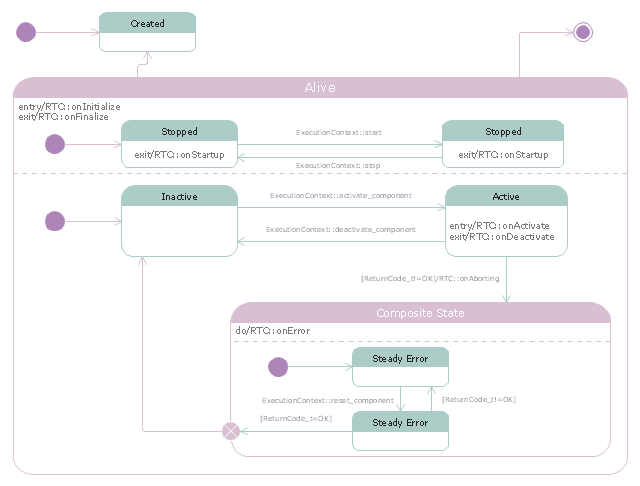"RT-middleware (Robotics Technology Middleware) is a common platform standards for Robots based on the distributed object technology. RT-middleware supports the construction of various networked robotic systems by the integration of various network enabled robotic elements called RT-Components. The specification standard of the RT-component is discussed / defined by the Object Management Group (OMG). ...
In the RT-middleware, robotics elements, such as actuators, are regarded as RT-components, and the whole robotic system is constructed by connecting those RT-components. This distributed architecture helps developers to re-use the robotic elements, and boosts the reliability of the robotic system.
Each RT-component has port as an endpoint for communicating other RT-components. Every port has its type and the ports which have the same type can be connected each other.
RT-components also has its state, so the RT-components behaves as state machines. The states that RT-components can have are CREATED, INACTIVE, ACTIVE, and ERROR, and the states and behaviors are controlled by the execution-context. If developers want to change the behavior of their RT-components, the execution-context can be replaced at run-time." [RT middleware. Wikipedia]
The UML state machine diagram example "State transitions of RT-component" was created using the ConceptDraw PRO diagramming and vector drawing software extended with the Rapid UML solution from the Software Development area of ConceptDraw Solution Park.
In the RT-middleware, robotics elements, such as actuators, are regarded as RT-components, and the whole robotic system is constructed by connecting those RT-components. This distributed architecture helps developers to re-use the robotic elements, and boosts the reliability of the robotic system.
Each RT-component has port as an endpoint for communicating other RT-components. Every port has its type and the ports which have the same type can be connected each other.
RT-components also has its state, so the RT-components behaves as state machines. The states that RT-components can have are CREATED, INACTIVE, ACTIVE, and ERROR, and the states and behaviors are controlled by the execution-context. If developers want to change the behavior of their RT-components, the execution-context can be replaced at run-time." [RT middleware. Wikipedia]
The UML state machine diagram example "State transitions of RT-component" was created using the ConceptDraw PRO diagramming and vector drawing software extended with the Rapid UML solution from the Software Development area of ConceptDraw Solution Park.
- Diagramming Software for Design UML State Machine Diagrams ...
- Design elements - Rapid UML solution (component diagram ...
- Circuits and Logic Diagram Software | Flowcharts | Gym and Spa ...
- Context Diagram Template | DFD Library System | Data Flow ...
- Data Flow Diagrams (DFD) | IDEF0 Diagrams | What Is Information ...
- UML Component Diagram | Diagramming Software for Design UML ...
- Process Flowchart | UML Component Diagram. Design Elements ...
- ConceptDraw PRO Network Diagram Tool | Network Diagram ...
- Design elements - Machines and equipment | Design elements ...
- State Diagram Example - Online Store | Diagramming Software for ...
- Diagramming Software for Design UML Component Diagrams | UML ...
- Design elements - UML state machine diagrams | Design elements ...
- Events BPMN 1.2 - Vector stencils library | Messages - Vector ...
- Fluid power equipment - Vector stencils library | Hydraulic 4-ported 3 ...
- Fire Exit Plan. Building Plan Examples | Fire and emergency ...
